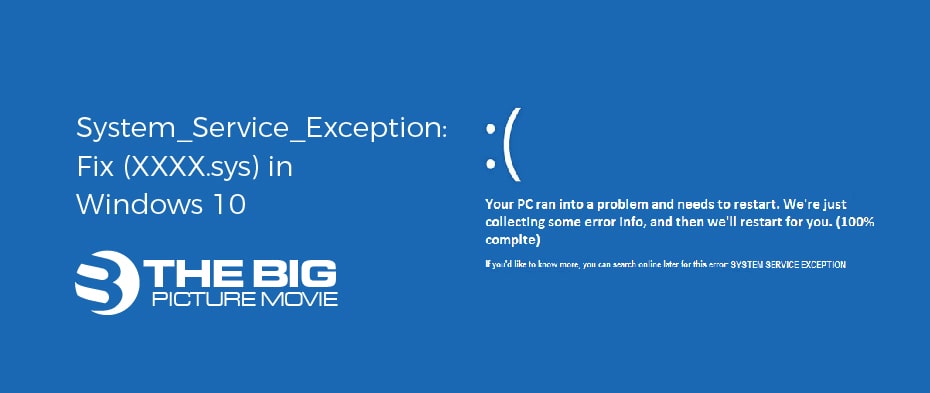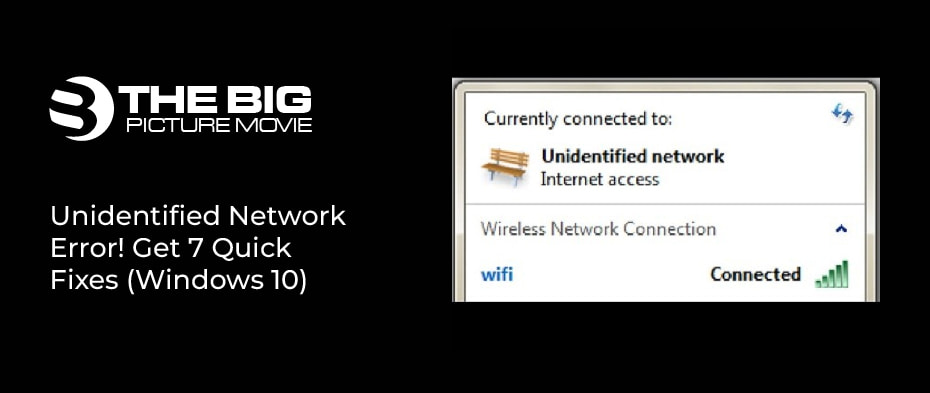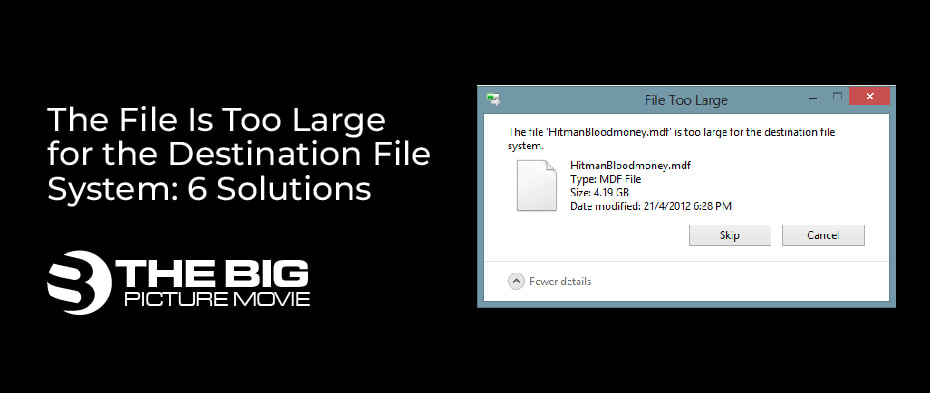
The File Is Too Large for the Destination File System: 6 Solutions
It is quite disturbing when an error message “the file is too large for the destination file system” appears on your screen when you want to upload a file or folder to your USB. even though the storage is accessible on the device. So, it is a worrying and complicated issue that most Windows users have to deal with. But don’t worry; we will discuss an abundance of solutions in the next section. However, the issue often occurs when you try to shift a file larger than 4GB. Don’t worry; exaggerate the error because we made the content that helps you solve the issue. Now let’s jump to the next section.
Reason Why “File Is Too Large for The Destination File System Error” Occurs
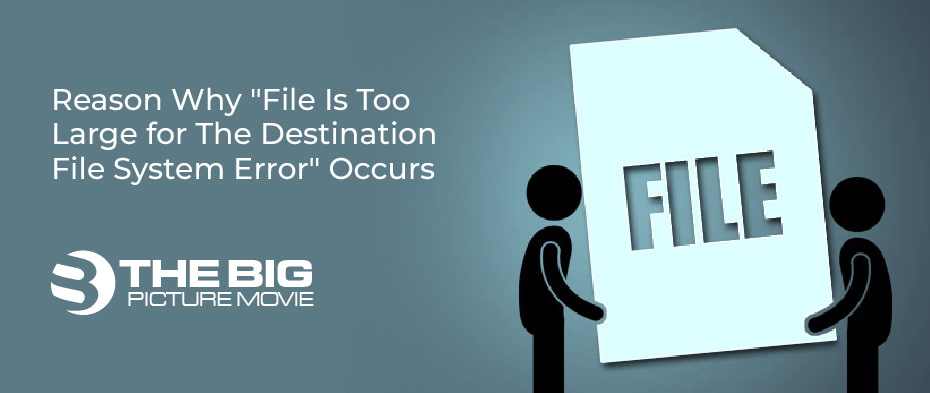
Have you ever encountered the “File too large for the destination file system” error on your computer (Windows 10, 8, 7)? You might be worried about this problem and want to resolve this error. At first, you have to know why this error occurs and why you cannot copy-paste the File even though there is enough space.
There is a limitation in the sizes of FAT16, FAT32, exFAT, and NTFS file systems. The main reason is when you transmit the File larger than your flash drive file system, the system will give you the error. Before we move to the solutions, we must know about these file systems. Let’s have a look.
FAT16: FAT or FAT16 are the elementary files of windows. The FAT file allows only less than 2 GB file size to be uploaded.
FAT32: FAT32 File is perfect for a hard disk with lower storage. The FAT32 File system allows a 4 GB file size to be uploaded.
NTFS: NTFS is a common file system and excessive for hard disks with the size of 16 TB storage.
ExFAT: it is a modern file system used in high storage. The ExFAT or FAT64 files are not well suited for many stages.
Fixes to Resolve “File Is Too Large for The Destination File System” Errors
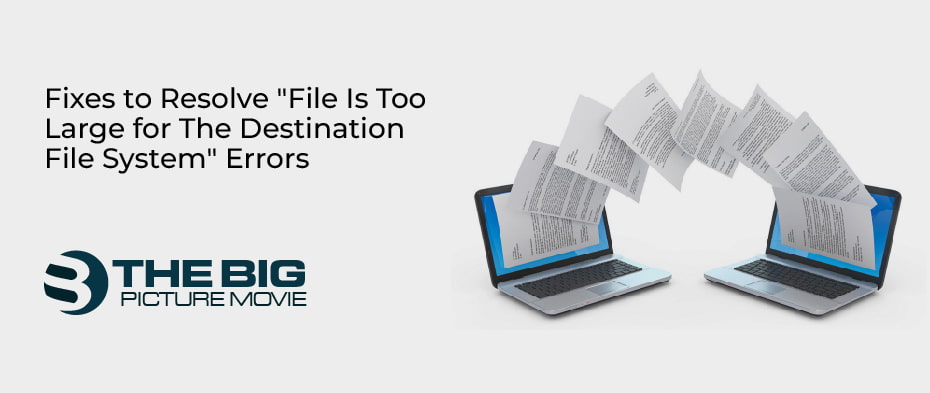
Now you understand the reason for this error. So to resolve this issue on your windows, you don’t have to hesitate. We have listed detailed solutions. Now let’s move to the steps.
-
Format the Files on a USB Flash Drive
Changing the file format of your storage device (USB) will erase all the data from the file. So we always recommend you make a backup plan for it. For proceeding, apply the below instructions.
- Attach the USB flash drive to your windows or computer.
- Click on the file explorer, then right-click on the storage file you want to format.
- Click on the Format option from the popup menu.
- In the format section, click on the file system.
- Then select the NTFS
- Go for the quick format option, tap on start, and wait for the completed message.
When the format is completed, you can send your file without the error.
-
Transfer the FAT32 file system to the NTFS file
As you know that FAT32 files can receive and send 4 GB or smaller files. So you have to change the file format of FAT32 files into the NTFS files to transfer. This method also removes your file data. So keep the data in another file. These are the steps to proceed with the FAT32 file into NTFS.
- Open the command prompt from the search bar.
- Fill in the command details that it was asking.
- After filling the commands, press the enter
- The command will also ask you to type the storage level to process. That’s it.
-
Transfer the FAT32 files to ExFAT
Suppose you want to change the FAT32 file sizes into the exFAT file format to transfer files or folders. But keep in mind that formatting the file size will remove all the data from the files or folder, so make a backup plan before processing the procedure. To do this process, follow the below guide to transmit the file into the file destination system.
- Open the file explorer on your computer.
- Right-click on the drive that you want to transmit.
- From the popup menu, select the format
- Select exFAT and then click on the start
-
Divide the large files
If you move a folder or a file, you need the NTFS or FAT32 file system. If the folder is more significant than the destination file system, you can try to upload the file or folder individually, not in the collection view. Whenever you send a file or folder too large to the destination (USB), select one file smaller than the whole folder.
-
Reduce the file size
There are different fixes for the error message (the file is too large for the destination file system) we described to you. Another method is to reduce the file size to upload it onto the USB without changing the file format system. Using 7-Zip, GSplit, and another third-party tool would be best to reduce the file size. So here are the steps you can follow to split the files using the 7-Zip application to fix the error.
Using 7-Zip to Split the file
- First, download the 7-Zip application on your windows.
- Now right, click on the file that is large for the destination.
- A menu will appear on your screen. Here choose add to archive
- Now name the archive from the dialog box.
- Then select the file size from split to volume from the menu box.
- After that, click on the OK option to start the process.
-
Try with Another storage Device
If the above fixes did not resolve your error of the file is too large for the destination file system, you have the last option to use as an alternate. Buy using a new model of USB with a more extensive storage system that allows you to transfer the files without any interruptions.
Tip: you can also place all your data on the cloud. This option is go-to and handy for you.
Wrapped up
The file is too large for the destination file system, causing the error seen by many people. However, you can fix the file error using the methods we already shared in this article. You must try these fixes to resolve your error. If you are using the Windows built-in features to switch the file systems, you must have to back up the files on the storage device, as it can erase all your data. So, if you have any other options, let us know in the comment box.


